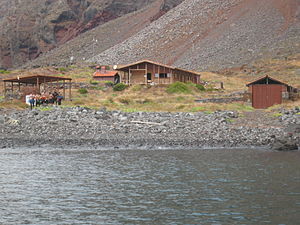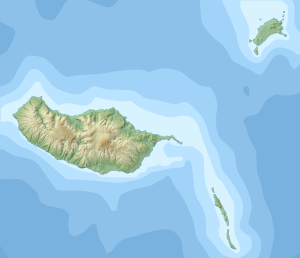Deserta Grande
| Deserta Grande | ||
|---|---|---|
| Research station on Deserta Grande | ||
| Waters | North Atlantic | |
| Geographical location | 32 ° 31 ′ N , 16 ° 30 ′ W | |
|
|
||
| length | 11.7 km | |
| width | 1900 m | |
| surface | 10 km² | |
| Highest elevation | 479 m | |
| Residents | uninhabited | |
Deserta Grande is the largest island of the Portuguese Ilhas Desertas , 23 km southeast of Madeira Island in the North Atlantic . To the south lies the island of Bugio and to the north the island of Ilhéu Chão . Except for one research station, the island is uninhabited.
geography
Deserta Grande has an area of 10 km² and reaches an altitude of 479 m . From Ponta da Castanheira in the north to Ponta do Tabaqueiro in the south, the island is 11.7 km long, with a maximum width of just 1900 m. Along the coast there are numerous caves, but also beaches and small bays, between the rocks. The Fajã Grande and the Fajã da Doca , the two largest bays, were created by simultaneous landslides in the west and east of the island in 1894.
fauna
The very rare Deserta tarantula ( Hogna ingens ), a wolf spider (Lycosidae) with a body length of up to four centimeters, lives only on Deserta Grande . It occurs mainly in caves and crevices on the volcanic island.
Individual evidence
- ↑ Reserva Natural das Ilhas Desertas: Desertas - área protegida reconhecida pelo conselho da Europa , accessed on July 29, 2014.

